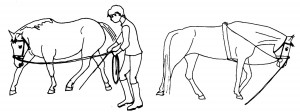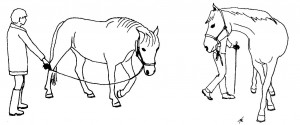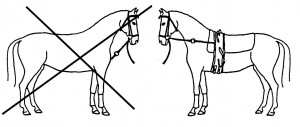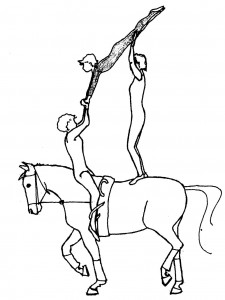Work on the Lunge Line – Part 12
|
|
Arbeit an der Longe – Teil 12
|
Auxiliary Reins:
- Up to now, with our playful preparation, our horse has learned the concept of the circle and seeking the contact to the human hand over the long rope or lunge line. He has learned to watch our body language and will willingly react and yield to it and therefore also to our whip signs.
- Auxiliary Reins were up to here not necessary. So what are they for? They should never bring the horse into a certain position by coercion, but rather help him to find the way to the correct position himself. Regarding contact to the lunger’s hand auxiliary reins replace the rider’s hand to a degree.
- The topic of auxiliary reins is a tricky one. All books tell you that the use of this tool can do great damage to the horse, when in the wrong hands. But how do you know, whether your hand is the “wrong” one?
- Auxiliary reins are “helping” reins. They might help the lunger, who has problems without them, but I believe their true purpose should be to help the horse.
- Working on the lunge line is only really effective, if you get the horse to relax his top line, lift his back and stretch downward and forward into the bit. We try to achieve this relaxation of the neck by lateral flexions (adhering to the School of Légèreté) and we will only use auxiliary reins in training, which permit free mobility of the horse’s neck in horizontal directions. (This excludes some side-reins for training a priori, which we will discuss later).
|
|
Hilfszügel:
- Bis jetzt hat unser Pferd, mit unserer spielerischen Vorbereitung, das Konzept des Zirkels und daß es den Kontakt zur menschlichen Hand über die Longe suchen soll, verstanden. Es hat gelernt auf unsere Körpersprache zu achten und willig auf unsere Signale und Peitsche zu reagieren.
- Hilfszügel waren bis hierher nicht nötig. Wofür brauchen wir sie also? Sie sollen niemals das Pferd in eine Zwangshaltung bringen, sondern ihm helfen, den Weg in die richtige Haltung zu finden. In punkto Anlehnung ersetzen die Hilfszügel beim Longieren die nicht vorhandene Reiterhand.
- Das Thema der Hilfszügel ist ein leidiges. Alle Bücher sagen Ihnen, daß die Benutzung dieses Werkzeugs in der falschen Hand großen Schaden anrichten kann. Woher wissen Sie aber, ob Ihre Hand die “falsche” ist?
- Hilfszügel können dem Longenführer helfen, der vielleicht ohne sie nicht weiter weiß. Aber wirklich sollten sie dazu da sein dem Pferd zu helfen.
- Das Ziel der Longenarbeit in der Ausbildung des Pferdes kann nur erreicht werden, wenn das Pferd lernt seine Oberlinie zu dehnen, den Rücken aufzuwölben und sich vorwärts-abwärts an das Gebiß heranzustrecken. Wir bemühen uns diese Entspannung durch laterale Biegung zu erreichen (Schule der Légèreté) und werden im Training nur solche Hilfszügel benutzen, die eine freie Beweglichkeit des Halses in horizontaler Richtung erlauben. (Das schließt manche Hilfszügel von vorn herein aus, die wir noch besprechen werden).
|
 The two left drawings show the correct way: horizontal! the drawing on the right is a NO! copied from “Une certaine idée du dressage, Odin à Saumur”, 1999 Philippe Karl
|
- The way down – extension posture:
- Auxiliary reins can help the horse to find the way down. But a horse, which is running with head high and hollowed back, does so for a reason: either he is too exuberant (let him get rid of his bucks off-line first) or he is afraid (gain his trust and respect with leading games first). If you tie down a frightened horse with side reins, you will only increase his panic and lose his trust even more.
|
|
1. Der Weg in die Tiefe – Dehnhaltung:
- Hilfszügel können dem Pferd den Weg in die Tiefe weisen. Aber ein Pferd, welches mit hohem Kopf und durchgedrücktem Rücken dahin stürmt, hat dazu einen Grund: entweder es ist zu übermütig (dann lassen Sie ihn sich erst mal ohne Longe ausbocken) oder es hat Angst (dann müssen Sie erst sein Vetrauen gewinnen). Wenn man ein verängstigtes Pferd mit Ausbindern nach unten zwingt, verstärkt man seine Panik und verliert sein Vertrauen noch mehr.
|
 Left you see a natural relaxation posture. On the right the horse finds the way down with running reins. |
- The extension posture while working on the lunge line is often misunderstood. It does not signify that the horse just lets his head and neck fall and snorts contentedly – this I would call a relaxation posture. As long as he does not step under with the hindquarters, and as long as he perhaps even falls onto the inner shoulder, the goal of our training is not in sight.
- Let’s include another Pre-game Crossing Legs on a Small Volte (book “LtL” page 132 and film “Playing with Horses”). This game is very useful, it deepens the respect, as the horse has to accept you in the “driving” position, and it teaches the horse to bend on a circle line naturally. The horse learns to find his balance in curves and, as the crossing steps get wider, he mobilises his spine and hip joints.
- The goal of this gymnastic exercise is to bring the inner hind leg as far as possible to the front and under the gravity point and to lighten the inner shoulder. Work in a calm tempo and check that the inner hind leg steps into the track of the outer front hoof. It would be a good sign if the horse lets his neck fall at this point and starts to chew.
|
|
- Die Dehnungshaltung beim Arbeiten an der Longe wird oft mißverstanden. Sie bedeutet nicht, daß das Pferd lediglich den Kopf und Hals fallen läßt und zufrieden abschnaubt – das würde ich Entspannungshaltung nennen. Solange es mit der Hinterhand nicht anständig dabei untertritt und sich vielleicht auch noch in Schieflage auf die innere Schulter fallen läßt, ist das Ziel der Arbeit nicht in Sicht.
- Hier wollen wir ein weiteres vorbereitendes Spiel einfügen: das Übertreten auf der kleinen Volte (wie im Buch “FLtoL” auf Seite 132 und im Film “Playing with Horses” gezeigt). Dieses Spiel vertieft den Respekt, da da Pferd uns in der “treibenden” Position akzeptieren muß, und es lehrt es, sich natürlich auf der Zirkellinie zu biegen. Es findet seine Balance in der Kurve und mobilisiert, wie die kreuzenden Schritte weiter werden, seine ganze Wirbelsäule und das Hüftgelenk.
- Das Ziel dieser Gymnastik ist es, das innere Hinterbein soweit wie möglich nach vorne unter den Schwerpunkt zu bringen und die innere Schulter zu entlasten. Man arbeitet in ruhigem Tempo und achtet darauf, daß das innere Hinterbein in die Spur des äußeren Vorderhufs tritt. Ein gutes Zeichen ist, wenn das Pferd nun hierbei den Hals fallen läßt und zu kauen beginnt.
|
 Crossing legs on the small volte – see “From Leading to Liberty” and “Playing with Horses”
|
- Auxiliary reins should assist the horse in both these goals: the relaxation of the horse in correct posture, and the bending and balancing on the circle. But we must understand the effects and the limits of the utilizability of auxiliary reins.
- Auxiliary reins limit the horse, if and when he departs too far from the desired posture. The ideal case would be that the horse understands via their guidance to stretch forward in light contact to the bit.
- With a horse that still runs or fights you on the lunge line auxiliary reins may not be hooked into the bit, but rather into the cavesson or halter. According to measurement of trainer Fritz Stahlecker, a normal rein in contact already exerts pressure of a kilogram onto the tongue of the horse. During an exuberant bounce of a horse on side reins this pressure can easily increase to 80 kilo. This significant pain will very quickly destroy trust and de-motivate the horse. If the mouth of your horse is sacred to you, normal side reins are OUT for training!
- With straight side-reins the horse becomes fixed in his posture. When the horse is thus forced into a certain position it is not only the development of the musculature which suffers but also the psyche of the horse. Side-reins hinder a horse in going forward. Fritz Stahlecker (a famous German trainer) calls the use of side-reins “shackles, which could not be more absolute”. He measured that taut side-reins exert a pressure of 10 to 20 kilos on the bit. So as long as you and your horse are still learning all auxiliary reins as well as the lunge line should be hooked into the cavesson to spare the horse’s mouth!
|
|
- Hilfszügel sollen dem Pferd in der Erreichung beider Ziele helfen: dem der Entspannung in korrekter Haltung und dem des Biegens und Ausbalancierens auf dem Zirkel. Wir müssen aber die Auswirkung von Hilfszügeln und die Grenzen ihrer Einsatzfähigkeit verstehen.
- Hilfszügel begrenzen das Pferd, falls es sich zu weit von der gewünschten Haltung entfernt. Der Idealfall wäre, wenn das Pferd begreift, daß es sich selbst in leichter Anlehnung über den Hilfszügel an das Gebiß herandehnen soll.
- Bei einem Pferd das sich wehrt dürfen Hilfszügel nicht in das Gebiß verschnallt werden, sondern in den Kappzaum. Ein normal anstehender Zügel übt (nach Messungen von Fritz Stahlecker) schon einen Druck von einem Kilogramm auf die Zunge aus. Bei einem übermütigen Satz eines ausgebundenen Pferdes kann sich dieser Druck bis weit über 80 Kilo verstärken. Hier wird durch großen Schmerz ganz schnell Vertrauen zerstört und das Pferd demotiviert. Wenn Ihnen das Pferdemaul heilig ist, sind normale Ausbilder OUT für Ihr Training!
- Durch Ausbinder wird das Pferd wird in seiner Haltung fixiert. Wenn ein Pferd so in eine Zwangshaltung gebracht wird, leidet nicht nur die Entwicklung der Muskulatur, sondern auch die Psyche des Pferdes darunter. Der Ausbinder hemmt das Pferd im Vorwärtsgehen. Fritz Stahlecker nennt die Anwendung von Ausbindern eine “Fesselung, die absoluter nicht sein könnte”. Er hat gemessen, daß der Ausbinder, wenn er ansteht, schon einen Druck von 10 bis 20 Kilogramm auf das Gebiß ausübt. Bei einem Longenführer, der noch lernt, und ebenso bei einem Pferd, das noch in der Ausbildung ist, müssen also Ausbinder sowie auch Longe im Kappzaum verschnallt werden, um das Pferdemaul zu schonen!
|
 Stoßzügel – straight side-reins – are counter-effective in training. In vaulting competition they are required by the rules. |
- So please take note that in vaulting there are grave differences between schooling the horse and giving a performance! In vaulting competitions we still see straight side-reins (which for schooling a horse have long been looked down upon) because they are prescribed in the rules. A certain justification is that while performing exercises on the hors’s neck it is necessary to fix this in position, as otherwise a sudden lowering of the neck would surely mean a fall for the vaulter on it. But during training at home one should work with running side-reins, which are much better for the horse!
- When straight side-reins are employed do not forget to frequently offer breaks and unhook them, so that the horse can stretch. In a posture of coercion (and with straight side-reins the horse is being coerced!) his muscles cramp up, which results in pain.
|
|
- Wir müssen also darauf hinweisen, daß in der Voltige, Unterschiede zwischen Ausbildung und Show Vorstellung bestehen. In Voltigierwettkämpfen sehen wir immer noch seitliche Ausbinder, (die für die Ausbildung des Pferdes schon längst verpönt sind) da sie eben leider im Reglement noch vorgeschrieben sind. Eine gewisse Berechtigung besteht darin, daß beim Turnen auf dem Hals des Pferdes dieser eben in der Bewegung beschränkt werden muß – ein plötzliches Absenken des Halses würde sicherlich zum Absturz der sich dort befindenden Voltigierer führen! Im Training zu Hause aber kann man durchaus mit Dreieckszügeln arbeiten, die wesentlich schonender sind!
- Wenn Ausbinder zum Einsatz kommen, darf man nicht vergessen, immer wieder Pausen einzulegen und die Hilfszügel dabei auszuhängen, damit das Pferd sich strecken kann. In einer Zwangshaltung (und mit Ausbindern ist das Pferd in einer!) verkrampfen sich die Muskeln, was schmerzhaft ist.
|
- Here the side-reins prevent the horse from suddenly dropping his neck, which could result in a fall of the vaulter.

|
| To be continued next time with an overview over auxiliary reins |
|
Weiter gehts nächstes Mal mit einem Überblick über gängige Hilfszügel |






